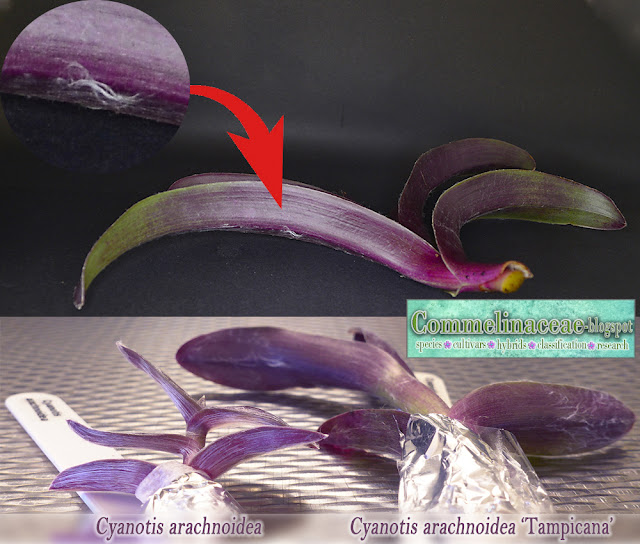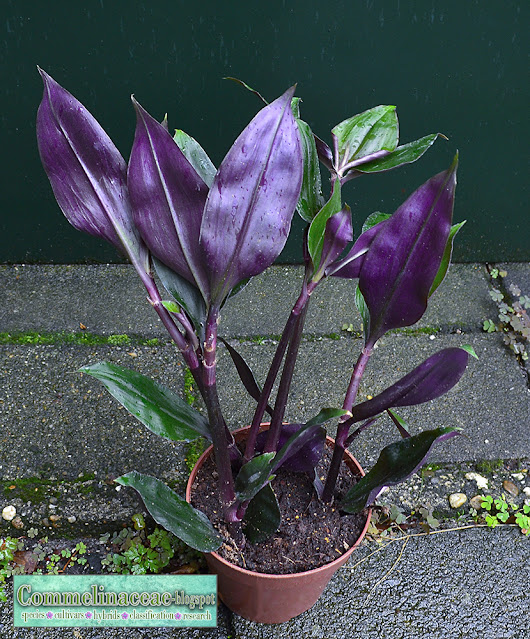created: Oct. 30, 2021 updated: Oct. 31, 2021  |
| In this drawing we see the two forms of Gibasis pellucida: forma I (with large leaves), forma II (with smaller leaves). Both have glabrous leaves. On the upper right is the Gibasis geniculata, with fuzzy leaves. |
In this article we are going to examine the taxons of Gibasis pellucida, Gibasis geniculata, Tradescantia multiflora, Tradescantia multifolia, Tripogandra multiflora and a vernacular name that connects all these which did bring a lot of confusion among the Commelinaceae plant community up until the time of writing.
Introductory information
In 1993 the plant with the common name Tahitian Bridal Veil was selling like crazy in the USA and Canada, and a little later in Europe. It was a fancy plant with small
glabrous leaves, green on the upper part and purple on the underneath. With a dense foliage and abundance of white flowers, flowering almost non-stop, making it as such a very beautiful hanging plant to have. The initial scientific name that was assigned to this plant was
Tradescantia multiflora (multiflorus: multi [many] + florus [flowers]). And by some growers the species epithet
multifolia (folia: leaved) was used instead:
Tradescantia multifolia, to describe its dense foliage. However, none of those botanical names were backed up with scientific literature. The
Hortus Third concise dictionary of plants cultivated in the United States and Canada, had listed the scientific name
Tradescantia multiflora as a synonym of
Tripogandra multiflora (Swartz) Raf., Fl. Tellur. 2: 16 (1837) back in 1982
[1, 2, 3, 4]. But the problem of no citation that could connect the vernacular name Tahitian Bridal Veil to either of those botanical names was still an issue.
Then came L. Graf in 1978 and 1992 citing the taxon
Tradescantia multiflora as a synonym of
Gibasis geniculata (Jacq.) Rohweder. Then Robert E. Woodson reported in 1981 that what was sold as a Tahitian Bridal Veil was a selected form of
G. geniculata and cited
Tradescantia geniculata and
Aneilema geniculatum (Jacq.) Woodson. The same author, Robert E. Woodson described in 1981
G. geniculata with hairless leaves, whereas Anthony J. Huxley in 1992 described
G. geniculata as bearing
villous (fuzzy) leaves. D. R. Hunt in 1986 associated Tahitian Bridal Veil with
G. pellucida. but there was no citation of
Tradescantia multiflora in neither of the
Gibasis taxons (
G. geniculata;
G. pellucida).
Taxonomic evidence
Then at North Carolina State University Tahitian Bridal Veil plants were cultivated and examined in order first to validate their genus (
Gibasis,
Tradescantia, or
Tripogandra) and secondary to distinguish their species. The growth habit of Tahitian Bridal Veil is creeping, with stems as slender as 1 mm in diameter, with asymmetrical leaves,
ovate-lanceolate to
lanceolate,
acute to short
acuminate,
glabrate (somewhat glabrous), dark green above to dark reddish-purple below, having lateral veins, 24 mm long. The inflorescence is born from upper
axils and is mostly terminal and
stipitate, with
cincinni free,
binating above the
stipe. And the stipe is green approx. 12 - 24 mm long.
Tripogandra plants have flowers that are
zygomorphic,
sessile with fused cincinni and unequal stamens. Thus the
Tripogandra genus was excluded.
 |
| Typical Gibasis (left) and Tradescantia (right) inflorescences. |
Then the most easier task was to tell the inflorescence of
Tradescantia in relation to that of
Gibasis. In particular, the inflorescence of
Gibasis has
cyme bracts that are reduced to the point of appearing absent.
Tradescantia on the other hand possesses large, spathaceous bracts
[5].
The next step was to identify the correct species of Tahitian Bridal Veil within the genus
Gibasis. D. R. Hunt provided in 1986 a revision of
Gibasis that included a key to identifying the species
[2]. In the
Gibasis genus there are only three species that produce white flowers:
G. geniculata,
G. oaxacana and
G. pellucida.
G. oaxacana is easy to tell by her three to eight cincinni in an
umbel and
petiolate leaves spirally arranged.
G. geniculata is distinguished easily by her paired cincinni; sessile, densely
villous leaves that are
distichate (2-ranked on the stem).
G. pellucida is easily distinguished by paired cincinni, sessile glabrate leaves that are also distichate.
 |
G. oaxacana vs G. pellucida vs G. geniculata[2]
|
 |
Gibasis pellucida (forma I) with the larger leaves.
photo from Erica Jane |
Two forms of Gibasis pellucida
There have appeared among Commelinaceae plant collectors two forms of G. pellucida. Gibasis pellucida (forma I) with large leaves and thicker stems and Gibasis pellucida (forma II) with small leaves and slender stems up to 1 mm in diameter.
In particular, these two forms have enough morphological characters to recognize them as different taxa, not at species level, but as subspecies or varieties. But, extensive field collection and characterization is needed also to confirm this preassument[6]. As already described in the revision papers above, both plants have glabrate (somewhat smooth) leaves. Only the G. geniculata has clearly visible villous (fuzzy) leaves.
 |
| Gibasis pellucida (forma II) with the small leaves. |
P.S.: the article will be updated in the following days with photos from the two different forms of Gibasis geniculata. So stay tuned.
_________
References (main sources: 1, 2)
6. Communication with Spanish botanist Pere Fraga Arguimbau.
.










































